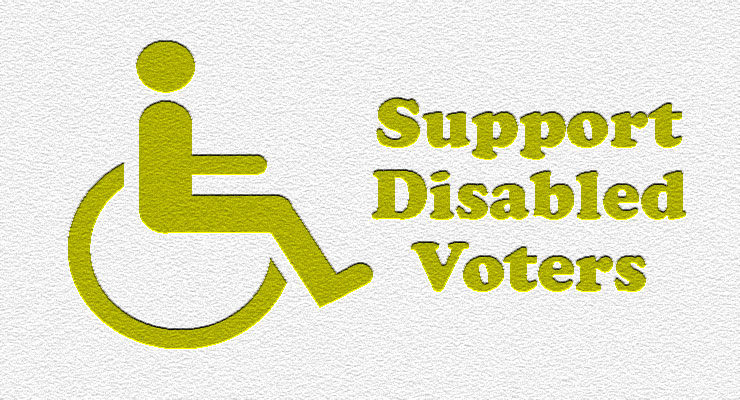
There are various types of barriers facing voters including photo ID requirements, voting booth availability, the flexibility of poll hours, and the availability of time off from work with pay for voting. Some states even have financial penalties for the violation of deadlines or rules related to registration lists. Disabled voters face these barriers and more. Stella Lorence writing for the Boston-based GBH news has the latest on this story from Massachusetts. Take a look:
Designing a mail-in voting system that accounts for the variance in ability is a challenge many states are still struggling with. The National Federation of the Blind is working with its affiliates in 23 states to make sure accessible systems are in place by November.
Even for blind voters who decide to go in-person to the polls, precautions against the coronavirus make navigating the voting experience more challenging. People lined up 6 feet apart make it difficult to locate the end of the line with a cane, and masks can obscure spoken directions. Before the pandemic, poll workers might take a blind person’s elbow to guide them to the voting machine. Now, they must maintain proper social distancing.
Use of the accessible mail-in system, however, relies on a voter having access to a computer, printer and the internet in the first place, and knowing how to use them.
Some interesting related research was published in the Election Law Journal where authors Quan Li, Michael J. Pomante II, and Scot Schraufnagel outline an innovative voting index system in their report titled “Cost of Voting in the American States”. The index helps reveal amazing data on how voting barriers vary by state.
According to the index’s findings for 2016, “voting was most difficult in Mississippi and… voting was easiest in Oregon, which was the only state to make use of automatic voter registration in 2016”. The poor state of Mississippi’s democracy should be a surprise to no one. Mississippi has no online voter registration system, no same-day voter registration, and no early voting. Photo ID is required. As a result of state voting laws, this year “little more than 13 percent of Mississippi’s registered voters (245,100 people) cast ballots in the June Republican and Democratic primaries”.
The Brennan Center for Justice published last May a 34-page must-read report titled, Purges: A Growing Threat To The Right To Vote, that explains what’s behind the rush to find large numbers of non-citizens voting. It is largely a scare tactic to enact voter purges.
The report was co-written by four expert authors from the Brennan Center including Jonathan Brater, Kevin Morris, Myrna Pérez, and Christopher Deluzio, and exposes how, in effect, the system is denying citizens their right to vote. The report looks at what happens when voters head to the polls and end up not voting due to the absence of their names on the voter’s registration list.
The total number of 16 million citizens who could not vote just within two years that is 2014 to 2016 could be as a result of death, change of residence, criminal conviction, and many others. But there are worrying signs that there is an abuse of rights going on according to the Brennan Center:
Most disturbingly, our research suggests great cause for concern that the Supreme Court’s 2013 decision in Shelby County v. Holder (which ended federal “preclearance,” a Voting Rights Act provision that was enacted to apply extra scrutiny to jurisdictions with a history of racial discrimination) has had a profound and negative impact:
The report goes through a long and detailed analysis comparing the voter purge rate of recent to that of past years. Their data clearly shows that the voter purge rate has increased dramatically in recent years. The introductory section of the report covers the tragedy of voters going to the polls with the full intention of having their opinion respected but finding out their names have been taken off the system for one reason or another. According to that introduction:
We found that between 2014 and 2016, states removed almost 16 million voters from the rolls, and every state in the country can and should do more to protect voters from improper purges.2 Almost 4 million more names were purged from the rolls between 2014 and 2016 than between 2006 and 2008.3 This growth in the number of removed voters represented an increase of 33 percent — far outstripping growth in both total registered voters (18 percent) and total population (6 percent).
The voter purge rate is so high today that there is a true risk to democracy. The report also offers solutions to the crisis, proposing that voter rolls should be kept highly accurate and ensuring voters have mechanisms to protect them from wrongful wrong purges. Will we listen?
Also see our section on American Democracy or our articles on Voter Turnout, the Internet and Voting, Military Voting or just general Voter Access.
Leave a Reply